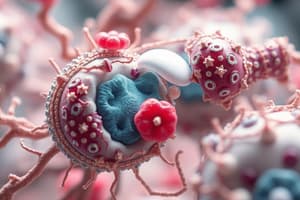Podcast
Questions and Answers
Which organelle is responsible for generating ATP, the cell's energy currency?
Which organelle is responsible for generating ATP, the cell's energy currency?
- Endoplasmic Reticulum
- Mitochondria (correct)
- Lysosomes
- Nucleus
What is the main function of the Golgi Apparatus in a cell?
What is the main function of the Golgi Apparatus in a cell?
- Protein synthesis and lipid production
- Break down waste products
- Package, modify, and transport proteins and lipids (correct)
- Generate ATP
Which organelle is referred to as the cell's genetic command center?
Which organelle is referred to as the cell's genetic command center?
- Lysosomes
- Peroxisomes
- Nucleus (correct)
- Endoplasmic Reticulum
What is the primary function of the Endoplasmic Reticulum in cellular activities?
What is the primary function of the Endoplasmic Reticulum in cellular activities?
Which organelle is involved in breaking down toxic substances and lipid metabolism?
Which organelle is involved in breaking down toxic substances and lipid metabolism?
How do Mitochondria contribute to cellular activities?
How do Mitochondria contribute to cellular activities?
What is the main function of lysosomes in a cell?
What is the main function of lysosomes in a cell?
Which organelle is involved in detoxification, lipid metabolism, and oxidative reactions?
Which organelle is involved in detoxification, lipid metabolism, and oxidative reactions?
How have physical sciences contributed to our understanding of cellular organization and function?
How have physical sciences contributed to our understanding of cellular organization and function?
What term best describes cellular organelles?
What term best describes cellular organelles?
How has the study of cellular organelles expanded our understanding of cell biology?
How has the study of cellular organelles expanded our understanding of cell biology?
Flashcards are hidden until you start studying
Study Notes
Exploring Cellular Organization: The Realm of Cellular Organelles
Cell biology delves into the inner workings of living organisms at the microscopic scale. At the heart of these intricate systems are cellular organelles, specialized structures designed to perform specific functions within the cell. In this article, we'll peek into the world of cellular organelles, examining their variety, roles, and interdependence.
Organelles: The Cell's Workforce
Cells have dozens of organelles, each with its own unique structure and function. Here's a brief overview of some key organelles:
- Nucleus: The cell's genetic command center, containing the DNA.
- Mitochondria: The cell's powerhouses, generating ATP, the cell's energy currency.
- Endoplasmic Reticulum (ER): Responsible for protein synthesis and lipid production.
- Golgi Apparatus: Packages, modifies, and transports proteins and lipids within the cell.
- Lysosomes: Digestive units that break down waste, dead organelles, and engulfed pathogens.
- Peroxisomes: Small organelles involved in the breakdown of toxic substances and lipid metabolism.
Interdependence: A Symphony of Cellular Functions
Cellular organelles work together to maintain the cell's health and function. Here are a few examples of their interdependence:
- The ER synthesizes proteins, which are then transported to the Golgi apparatus for further modification and packaging.
- Mitochondria generate ATP, which is used by all cellular processes.
- Lysosomes break down waste and damaged organelles, maintaining cellular homeostasis.
- Peroxisomes are involved in detoxification, lipid metabolism, and oxidative reactions.
Bringing Disciplines Together
As cell biology has progressed, the physical sciences have increasingly contributed to our understanding of cellular organization and function. By integrating mathematical models, computational simulations, and physical principles, researchers have gained insights into the complexity of cellular organization and dynamics.
Conclusion
Cellular organelles are the cell's specialized structures, designed to perform specific functions. Their interdependence and the contributions of the physical sciences to cell biology have expanded our understanding of cellular organization and function. As we continue to explore the inner workings of cells, our knowledge of cellular organelles and their roles will undoubtedly grow.
Studying That Suits You
Use AI to generate personalized quizzes and flashcards to suit your learning preferences.




